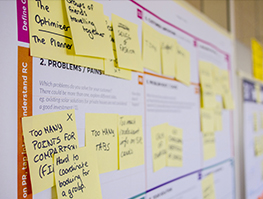Client Impact

Fueling a global expansion for a healthcare automation app
The market for healthcare automation is a very crowded and competitive one. This awareness led our client to engage Strategy DNA to discover an underserved and potentially less competitive market segment that would make full use of their app’s unique, and at the time unmatched, functions.
The process:
Strategy DNA conducted research to assess the potential size of this market segment. Our focus was on the unmet needs and desires of the uninsured and urgent care patient group. This research included realistic scenarios that would confirm our assumptions on the size of the potential market. The analysis included a review of U.S. doctors and clinics that provided services for the uninsured, particularly any that might target international travelers. The analysis also included a competitive analysis of leading suppliers in the medical automation market, with a special emphasis on pricing and positioning of services to the uninsured. This was followed by an overview of the Latin American market to help understand pricing differences and select the best country for market entry. The findings revealed that our clients’ app offered unique functions that allowed it to take patient engagement to a higher level. Our work also found key gaps in the marketplace.
The outcomes:
This project gave our client important insights into key market gaps and enabled the company to systematically target specific physician practices, in specific U.S. markets, with enthusiastic response. It also gave them a deeper understanding of the economic implications of the app’s adoption. This understanding enabled the India-based company to gain an initial foothold in the U.S. and expand into Latin America.

Preserving employee safety, client relationships, and the bottom line by enabling remote work
Strategy DNA helped a 30-person professional services company organize effective, fully-remote work in the early days of the coronavirus outbreak. Our involvement anticipated the mandatory activity shutdown by the federal government and ensured uninterrupted operation.
The Involvement:
Strategy DNA accepted the challenge this scenario presented and accomplished a complete technology transition within three business days. Our first step was to introduce a new approach to leadership and management that realigned the company around shared goals. At the same time, we provided project management for the shift to remote work, developed new processes, procedures and communication measures for employees and clients, and trained both the executive team and employees in how to maximize the power of their newly aligned organization.
The Result:
Our methods were adopted easily, with enthusiastic support of both management and employees. As a result, the staff began to work with little interruption from home almost two weeks ahead of the federally mandated activity shutdown. This allowed the company to not only timely fulfill all of its financial, tax, and contractual obligations, with a direct impact on over 30 percent of annual revenue, but submit successful RFPs for two new, large clients. Perhaps best of all, the work of Strategy DNA helped preserve employee morale and long-standing client relationships.

Supporting a Big 4 company in making investment decisions
A Big 4 professional services company needed to quickly understand and assess the market potential and competition for specific product/service offerings in a wide range of emerging technology areas – from AI and advanced analytics to cybersecurity, virtual reality, and robotics/automation, just to name a few. Strategy DNA helped the internal strategy and innovation group assess
the market potential for new areas of growth and investment.
This work included market and competitor research, market size and potential assessment, product/service development strategy, and portfolio fit. In addition, we created a database from a detailed probe into their top competitors in the space. We also performed competitive due diligence analysis where needed. This consisted of a competitive scan with multiple comparable solutions and a thorough investigation into the positioning of key competitors, particularly those with a significant service component.
Timely, accurate market intelligence allowed the company to make informed investment decisions. This saved the firm time and money since it avoided unproductive spending. Advancing internal thinking around the integration of products in a traditional professional services organizational context helped build the foundation for successful product development and management capability.

Improving alignment and performance of the corporate sustainability function
The functional leadership of an American industrial holding company needed to better understand the best practices in organizing and measuring the effectiveness of environmental health and safety issues. The requirement was prompted by the company’s ongoing work
establishing leadership in sustainability. To continue building on its progress, it needed to ensure that its internal organization was aligned with its ambitious goals.
How we helped:
We conducted a benchmarking study of environmental performance across the peer group of 10 large organizations. This work had a dual focus. It reviewed peer companies’ performance against environmental metrics. It also investigated the functional organizational structures of the groups responsible for environmental performance. More specifically, it sought to understand staffing levels, reporting structures and organizational alignment, key areas of focus, and the links between environmental organizations and the broader sustainability function. We distributed the blinded results across all utilities in the group and offered recommendations for further organizational development efforts.

Advancing IT for a portfolio company
A mid-size paper company, part of a private equity portfolio, was considering a significant investment to replace some of its aging systems. Cautious about the scale of investment, the owners needed to review and validate its IT strategy, evaluate architecture requirements, identify and assess options, alternative strategies and priorities, as well as costs, and develop a supporting business case.
How we helped:
We reviewed business systems requirements based on proposed solutions. This analysis involved risk identification and mitigation as well as the analysis of projected lifecycle costs for different solutions and business scenarios.
The outcomes:
An overall plan for the company was developed to introduce basic integrated applications and then address high-value-return specialty applications. These measures produced significant cost savings in both technology and business activities. These insights on the need for technological change, and the budget implications of different options, allowed the company to move quickly – and gaving investors the confidence necessary to support the move.

10 Days to a Decision: Strategy DNA Brings Speed and Clarity to an Acquisition
A private equity firm had 10 working days to decide whether to commit to an e-commerce opportunity within a niche market of the flooring industry. The deal was on the table. But before they signed off on it, they needed to understand the trends and market size that impacted the
deal’s potential.
The firm behind this search was an interesting investment opportunity. It concentrated on the needs of a visibly expanding market segment. Our initial discussion uncovered some of the key factors to its future profit potential, but many questions remained unanswered.
Our approach:
Strategy DNA conducted market research to validate key data points and assumptions provided by the target firm. Our goals were to ensure the long-term profitability, and the near-term performance, of this potential investment. The analysis was wide-ranging. We confirmed the size of the total addressable market, market share, and growth trends. Revealed key characteristics of customer behavior and the most and least attractive segments within the target customer population. Unearthed key competitive trends and discovered demographic and cultural shifts within the company’s target audience that could impact the segment’s future.
Outcome:
In less than 10 days, we were able to clarify the product-market fit of the company’s services and its customer value proposition. We also independently verified the total addressable market estimate and key variables and provided insights into the dynamics within the target market space to make informed decisions about the company’s future profit potential.
Our work provided the client with new confidence about key variables in this important investment decision, the clarity and momentum to move forward, and an appropriate level of detail necessary for a go/no-go decision that saved both time and money.

A global tech company capitalizing on new markets and partnerships
The Goal:
A global technology company needed to reposition one of its key software offerings to open new market opportunities and generate revenue. It also wanted to identify next-generation business partners to resell, OEM, or influence its products.
The Scope:
We provided a number of services to further this initiative. We thoroughly explored previously untapped markets as a source of new revenue. At the same time, we interviewed people within the company’s software group to understand both its successful existing and past partnerships and explore future alliances. This was supported by extensive research into what competitive companies do in their partner ecosystem. We also developed a set of principles that were applied to several potential next generation partners that the firm could go-to-market with to implement new capabilities. We also researched competitors of each brand and their partnership models.
The Focus:
Our search for new market opportunities and partnership strategies led us to examine a range of business partners. Our work was centered on midmarket (small and medium enterprises), with the exception of cloud computing and SaaS (software as a service) centered organizations. An examination of channels as critical growth drivers was also part of our work.
The Process:
Our work progressed through several stages. We conducted a business model and feasibility analysis. We then developed a marketing and channel strategy, product positioning, and go-to-market plan to promote the company’s software solutions in cleantech and energy efficiency markets. Finally, we proposed specific next-generation partnerships for the company’s software group.
The Outcome:
Immediately after project completion, a new partnership was announced with a leader in business application frameworks that link the power of the Internet of Things. The partnership’s goal was to make office buildings and retail stores more energy efficient. This partnership was the second to implement a strategy with the goal of up to 30 percent improved efficiency for everything from power grids to transportation systems.
The partnership led to the creation of a new lucrative line of business that culminated in the acquisition (within a year after the project) by the company of a provider of facility and real estate management software. This enabled the company to enter a new market and expand its footprint in the government sector as well, increasing its revenue by tens of millions of dollars annually.

Building efficiency and loyalty in state government
Difficult year. Difficult choice.
The year 2007 was difficult for the Maryland state government. An unexpected $1.5 billion budgetary shortfall made headlines all summer. State agencies went through multiple rounds of budget reductions to cover part of the deficit. To reduce spending, some agencies began to cut
funding for professional development, training, and promotions, as these were considered “perks.”
A fresh perspective:
We recognized that budget reductions were unavoidable. But we also saw that “non-essential” budget items had a negative affect on talent management and operating efficiency, especially as it applied to employee retention. Federal government professionals already earned up to twenty percent more than comparable state government employees. As a result, many state government managers had no hope to retain their best performers. Further, lost productivity and increased recruitment, training, professional licensing costs, and high turnover often resulted in significant hidden costs such as increased litigation caused by a lack of adequate enforcement or agency expertise. Even worse, government executives typically saw turnover as generating savings, without consideration for its long-term costs.
Confronted with high rates of turnover among engineering and research employees at the state-level environmental protection agency, we saw an opportunity to make a real difference in the way the state treated its employees. We approached the agency leadership with an unusual proposal. We recommended a satisfaction survey among almost 1,000 employees. Survey results revealed that institutional morale was abysmal. People were upset about poor communication, management, and working conditions, inept political appointees, the lack of recognition and promotion opportunities, and the trivial nature of daily operations, such as a fee to attend the employee appreciation picnic.
Over the next month, we examined agency turnover trends, recruitment practices, and compensation packages. Our inspiration and commitment energized the agency’s HR team, and together we began to brainstorm solutions and investigate non-monetary incentives. We shuttled constantly between the agency and the state’s central personnel and budget office. We also consulted repeatedly with Human Resources professionals in other states, survey participants, and agency leadership.
A successful outcome. A stronger agency.
The agency conducted a high-speed classification study that prompted the Governor to agree to a “soft”, HR-focused innovative initiative. This decision funded over $1.6 million annually in promotional opportunities for over 500 non-supervisory scientists and engineers. This action increased management quality and operating efficiency and reduced professional turnover. A new manager training program was also initiated, which created a more energized work environment. The Secretary of the state agency even publicly committed herself to improved employee satisfaction. In the following 10 years, the vacancy and turnover rate at the agency has been cut by half, including a significant portion of its scientific and technical staff.

Clarity of Impact
The Situation:
A global technology company needed to better understand the “theory of change” behind its community investment program, which seeks to impact communities where the company develops and operates its data centers. The company also needed to assess the appropriate level of community investment going forward.
Our approach and outcome:
We conducted a benchmarking study of community investment programs across the major industry players and identified both the annual amounts of community investment in various geographies – and the factors contributing to corporates’ decision making around setting community investment budgets. We have also defined the logic behind community investment and developed highly localized, mission-aligned sets of program priorities and key performance indicators allowing the company to continue to expand its geographic footprint in a socially-responsible way.

In the spirit(s) of change: Increasing IT effectiveness
An international wine and spirits manufacturer had completed major regionalization activities. The project defined and implemented new processes and reorganized its IT function, which served over 1,000 people. A year later, they commissioned an “IT audit” – an independent
review of the global CPG company’s IT effort. How we helped: We conducted a review of the division’s existing process documentation and key performance indicators (KPIs) and interviewed process owners, subject matter experts, customers, and practitioners across the division’s operations across the Americas. We developed a unique methodology to assess the effectiveness of the newly-integrated IT organization. Further, we provided a clear picture of adoption and compliance levels, process maturity, adoption/maturity progress in the last 12 months, and fit within the organization. We also offered recommendations for further process adoption and improvement, submitted action plans, and provided insight into barriers to implementation, such as leadership and stakeholder alignment issues. The outcome: Our work allowed the company to determine the return-on-investment (ROI) on its recent IT spending. It also outlined the next steps in its digital transformation. These measures allowed the IT function to become a meaningful part of a genuinely consumer-centric company and simplified and prioritized work methods for increased effectiveness.

Successful business outcomes through climate reporting leadership
One of the largest global producers of fertilizer failed to provide climate reporting to the Climate Disclosure Project (CDP). Further, the company did not fulfill other repeated requests for climate data between 2013 and 2018. This situation was prompted by a lack of reliable methods to collect internal data or assess climate-related risks. The inability to respond to such requests
damaged the company’s reputation among investors and customers. It also had the potential to lead to reduced access and increased cost of capital, loss of revenue, and an increase in future operating costs. This lack of preparation and transparency created a negative perception of the company and undermined its global expansion strategy.
How we helped:
In 2019, we were selected to prepare and submit the company’s first-ever CDP report. We worked closely with the organization to identify the steps necessary for a basic approach to climate reporting. This was accomplished despite the absence of prior collection efforts or attempts to assess and quantify climate risks and opportunities.
The outcome:
The organization’s international image improved as it began to disclose climate-related information. It also developed a plan to manage over $100 million per year in potential climate-related risks and to capitalize on over $200 million per year of new revenue opportunities.

Direct research and accurate survey data leads to market expansion for a foodservice equipment company
A North American buying group of commercial foodservice equipment needed to assess an opportunity to open a similar operation in Europe.
Strategy DNA provided a detailed analysis of overall sales of commercial foodservice equipment
and supplies, as well as by country and vertical industry (e.g. chain, hotel/business, independent dining, healthcare). We also conducted a competitive buying group overview that included markets served and distributor/supplier portfolio listings. In addition, we performed a ranking of top European equipment and supply distributors and their relative market share, and a similar ranking of leading equipment and supply dealers and their relative market share (whether through direct sales or through distribution partners, and industry trends).
Our work determined the ideal country for the operation’s location, based on opportunity size and business climate, projected growth in the foodservice equipment market, and explored power dynamics through the value chain, country comparisons, and initial positioning recommendations for the expansion.
Our primary survey research in Europe was conducted with a total of 884 experts. 32 industry professionals, with an average 16 years of experience, responded from 20 different countries.
Our work provided the clarity needed for expansion, supported a business case, showed how and where to compete, and helped determine the next steps in the expansion.

Bringing coordination and communication to a German tech company
The challenge:
An SAP instance rollout for the 1,000-person American division of a German technology conglomerate was significantly behind schedule and over budget. Review of the situation revealed widespread coordination and communication breakdowns between client and consultant
teams, and a lack of alignment by project stakeholders.
How we helped:
We were engaged to provide project management support to the internal rollout manager. Our work included establishing responsibility for the project plan and coordination of international client and consultant teams to ensure progress and reduce risks. We also reviewed and hired technical subcontractors, coordinated configuration and user acceptance testing, and developed rollout communications to align stakeholders.
The outcome:
We were able to return the focus to immediate operational needs and establish elements to help the client regain momentum and simplify user acceptance. Our actions resulted in a successful rollout that allowed the company to save money with the newer, more stable system.

Fueling growth through thoughtful product strategy
A major SaaS company considered investing in further development of a niche solution. As a result, they were faced with the decision to either continue to improve on the existing solution as part of future releases (part of the functionality of their flagship SaaS platform), or to spin it off and try to sell a separate product.
We helped the company understand the dynamics in the market, its commercial potential, and the best ways to position their product against their competition. This was followed by development of an initial approach to product strategy and go-to-market planning.
The outcome:
The updated product became part of a flagship new product release several months later. It received accolades for its vastly improved functionality and user experience. Its success contributed to drawing over $300 million in additional quarterly revenue and increased use by enterprise-level clients with higher annual contract value.